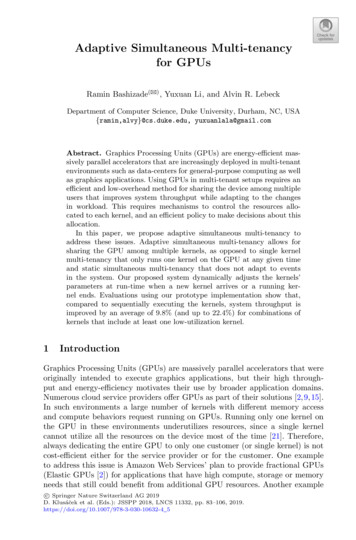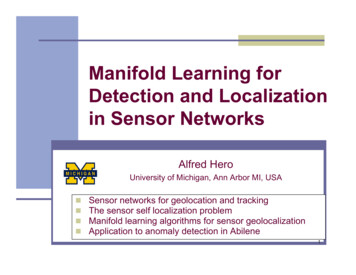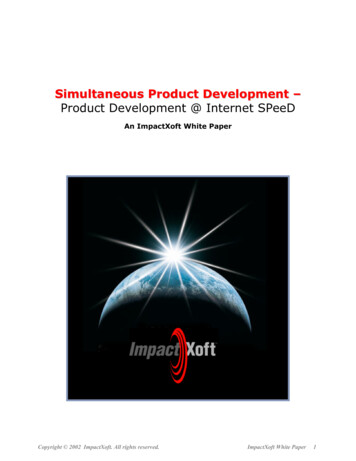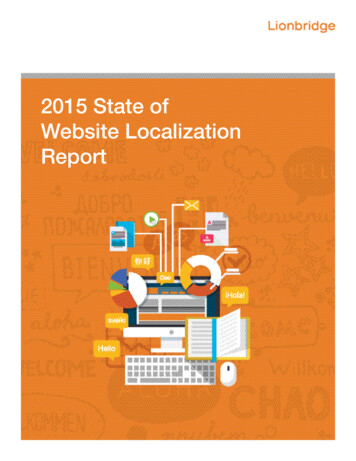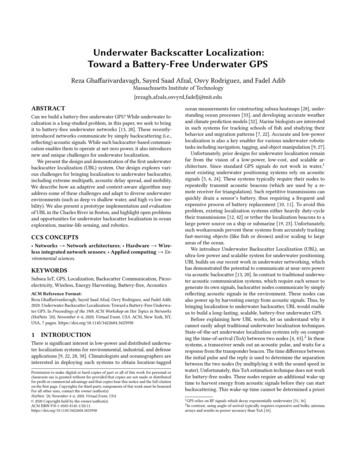
Transcription
1A Survey of Simultaneous Localization and Mapping with anEnvision in 6G Wireless NetworksBaichuan Huang1,2 , Jun Zhao1 Jingbin Liu21 NanyangTechnological University, SingaporeUniversity, Wuhan, China(huangbaichuan@whu.edu.cn)arXiv:1909.05214v4 [cs.RO] 14 Feb 20202 WuhanSimultaneous Localization and Mapping (SLAM) achieves the purpose of simultaneous positioning and map construction basedon self-perception. The paper makes an overview in SLAM including Lidar SLAM, visual SLAM, and their fusion. For Lidar orvisual SLAM, the survey illustrates the basic type and product of sensors, open source system in sort and history, deep learningembedded, the challenge and future. Additionally, visual inertial odometry is supplemented. For Lidar and visual fused SLAM, thepaper highlights the multi-sensors calibration, the fusion in hardware, data, task layer. The open question and forward thinkingwith an envision in 6G wireless networks end the paper. The contributions of this paper can be summarized as follows: the paperprovides a high quality and full-scale overview in SLAM. Its very friendly for new researchers to hold the development of SLAMand learn it very obviously. Also, the paper can be considered as dictionary for experienced researchers to search and find newinterested orientation.Index Terms—Survey, SLAM (Simultaneous Localization and Mapping), Lidar SLAM, Visual SLAM, 6G Wireless Networks.I. I NTRODUCTIONLAM is the abbreviation of Simultaneous Localization andMapping, which contains two main tasks, localization andmapping. It is a significant open problem in mobile robotics:to move precisely, a mobile robot must have an accurateenvironment map; however, to build an accurate map, themobile robots sensing locations must be known precisely [1].In this way, simultaneous map building and localization canbe seen to present a question of which came first, the chickenor the egg? (The map or the motion?)In 1990, [2] firstly proposed the use of the EKF (ExtendedKalman Filter) for incrementally estimating the posterior distribution over robot pose along with the positions of thelandmarks. In fact, starting from the unknown location ofthe unknown environment, the robot locates its own positionand attitude through repeated observation of environmentalfeatures in the movement process, and then builds an incremental map of the surrounding environment according to itsown position, so as to achieve the purpose of simultaneouspositioning and map construction. Localization is a verycomplex and hot point in recent years. The technologies oflocalization depend on environment and demand for cost,accuracy, frequency and robustness, which can be achieved byGPS (Global Positioning System), IMU (Inertial MeasurementUnit), and wireless signal, etc.[3][4]. But GPS can only workwell outdoors and IMU system has cumulative error [5]. Thetechnology of wireless, as an active system, can’t make abalance between cost and accuracy. With the fast development,SLAM equipped with Lidar, camera, IMU and other sensorssprings up in last years.Begin with filter-based SLAM, Graph-based SLAM play adominant role now. The algorithm derives from KF (KalmanFilter), EKF and PF (Particle Filter) to graph-based optimization. And single thread has been replaced by multi-thread. TheStechnology of SLAM also changed from the earliest prototypeof military use to later robot applications with the fusion ofmulti sensors.The organization of this paper can be summarized asfollows: in Section II, Lidar SLAM including Lidar sensors,open source Lidar SLAM system, deep learning in Lidarand challenge as well as future will be illustrated. SectionIII highlights the visual SLAM including camera sensors,different density of open source visual SLAM system, visualinertial odometry SLAM, deep learning in visual SLAM andfuture. In Section IV, the fusion of Lidar and vision willbe demonstrated, with several directions for future researchof SLAM. Section V illustrates the envision in combinationof 6G and SLAM. Conclusion is put in section VI. Thepaper provides high quality and full-scale user guide for newresearchers in SLAM.II. L IDAR SLAMIn 1991, [1] used multiple servo-mounted sonar sensors andEKF filter to equip robots with SLAM system. Begin withsonar sensors, the birth of Lidar makes SLAM system morereliable and robustness.A. Lidar SensorsLidar sensors can be divided into 2D Lidar and 3D Lidar,which are defined by the number of Lidar beams. In terms ofproduction process, Lidar can also be divided into mechanicalLidar, hybrid solid-state Lidar like MEMS (micro-electromechanical) and solid-state Lidar. Solid-state Lidar can beproduced by the technology of phased array and flash. Velodyne: In mechanical Lidar, it has VLP-16, HDL-32Eand HDL-64E. In hybrid solid-state Lidar, it has Ultrapuck auto with 32E.
2SLAMTEC: it has low cost Lidar and robot platformsuch RPLIDAR A1, A2 and R3. Ouster: it has mechanical Lidar from 16 to 128 channels. Quanergy: S3 is the first issued solid-state Lidar in theworld and M8 is the mechanical Lidar. The S3-QI is themicro solid-state Lidar. Ibeo: It has Lux 4L and Lux 8L in mechanical Lidar.Cooperated with Valeo, it issued a hybrid solid-state Lidarnamed Scala.In the trend, miniaturization and lightweight solid stateLidar will occupied the market and be satisfied with mostapplication. Other Lidar companies include but not limited tosick, Hokuyo, HESAI, RoboSense, LeddarTech, ISureStar,benewake, Livox, Innovusion, Innoviz, Trimble, LeishenIntelligent System. B. Lidar SLAM SystemLidar SLAM system is reliable in theory and technology.[6] illustrated the theory in math about how to simultaneouslocalization and mapping with 2D Lidar based on probabilistic.Furthre, [7] make surveys about 2D Lidar SLAM system.1) 2D SLAM Gmapping: it is the most used SLAM package in robotsbased on RBPF (Rao-Blackwellisation Partical Filter)method. It adds scan-match method to estimate theposition[8][6]. It is the improved version with Grid mapbased on FastSLAM[9][10]. HectorSlam: it combines a 2D SLAM system and 3Dnavigation with scan-match technology and an inertialsensing system[11]. KartoSLAM: it is a graph-based SLAM system[12]. LagoSLAM: its basic is the graph-based SLAM, whichis the minimization of a nonlinear non-convex costfunction[13]. CoreSLAm: it is an algorithm to be understood withminimum loss of performance[14]. Cartographer: it is a SLAM system from Google[15].It adopted sub-map and loop closure to achieve a betterperformance in product grade. The algorithm can provideSLAM in 2D and 3D across multiple platforms and sensorconfigurations.2) 3D SLAM Loam: it is a real-time method for state estimation andmapping using a 3D Lidar[16]. It also has back and forthspin version and continuous scanning 2D Lidar version. Lego-Loam: it takes in point cloud from a VelodyneVLP-16 Lidar (placed horizontal) and optional IMU dataas inputs. The system outputs 6D pose estimation in realtime and has global optimization and loop closure[17]. Cartographer: it supports 2D and 3D SLAM[15]. IMLS-SLAM: it presents a new low-drift SLAM algorithm based only on 3D LiDAR data based on a scan-tomodel matching framework [18].3) Deep Learning With Lidar SLAM Feature & Detection: PointNetVLAD [19] allows endto-end training and inference to extract the global descriptor from a given 3D point cloud to solve point cloud based retrieval for place recognition. VoxelNet [20] is a generic3D detection network that unifies feature extraction andbounding box prediction into a single stage, end-toend trainable deep network. Other work can be seen inBirdNet [21]. LMNet [22] describes an efficient singlestage deep convolutional neural network to detect objectsand outputs an objectness map and the bounding boxoffset values for each point. PIXOR [23] is a proposalfree, single-stage detector that outputs oriented 3D objectestimates decoded from pixel-wise neural network predictions. Yolo3D [24] builds on the success of the oneshot regression meta-architecture in the 2D perspectiveimage space and extend it to generate oriented 3D objectbounding boxes from LiDAR point cloud. . PointCNN[25] proposes to learn a X-transformation from the inputpoints. The X-transformation is applied by element-wiseproduct and sum operations of typical convolution operator. MV3D [26] is a sensory-fusion framework thattakes both Lidar point cloud and RGB images as inputand predicts oriented 3D bounding boxes. PU-GAN [27]presents a new point cloud upsampling network based ona generative adversarial network (GAN). Other similarwork can be seen in this best paper in CVPR2018 butnot limited to [28].Recognition & Segmentation: In fact, the method ofsegmentation to 3D point cloud can be divided into Edgebased, region growing, model fitting, hybrid method,machine learning application and deep learning [29].Here the paper focuses on the methods of deep learning.PointNet [30] designs a novel type of neural network thatdirectly consumes point clouds, which has the function ofclassification, segmentation and semantic analysis. PointNet [31] learns hierarchical features with increasingscales of contexts. VoteNet [32] constructs a 3D detectionpipeline for point cloud as a end-to-end 3D object detection network, which is based on PointNet . SegMap[33] is a map representation solution to the localizationand mapping problem based on the extraction of segmentsin 3D point clouds. SqueezeSeg [34][35][36] are convolutional neural nets with recurrent CRF (Conditionalrandom fields) for real-time road-object segmentationfrom 3d Lidar point cloud. PointSIFT [37] is a semanticsegmentation framework for 3D point clouds. It is basedon a simple module which extracts features from neighborpoints in eight directions. PointWise [38] presents a convolutional neural network for semantic segmentation andobject recognition with 3D point clouds. 3P-RNN [39] isa novel end-to-end approach for unstructured point cloudsemantic segmentation along two horizontal directionsto exploit the inherent contextual features. Other similarwork can be seen but not limited to SPG [40] and thereview [29]. SegMatch [41] is a loop closure methodbased on the detection and matching of 3D segments. KdNetwork [42] is designed for 3D model recognition tasksand works with unstructured point clouds. DeepTemporalSeg [43] propose a deep convolutional neural network(DCNN) for the semantic segmentation of a LiDAR scanwith temporally consistency. LU-Net [44] achieve the
3 function of semantic segmentation instead of applyingsome global 3D segmentation method. Other similar workcan be seen but not limited to PointRCNN [45].Localization: L3-Net [46] is a novel learning-basedLiDAR localization system that achieves centimeter-levellocalization accuracy. SuMa [47] computes semanticsegmentation results in point-wise labels for the wholescan, allowing us to build a semantically-enriched mapwith labeled surfels and improve the projective scanmatching via semantic constraints.C. Challenge and Future1) Cost and AdaptabilityThe advantage of Lidar is that it can provide 3D information, and it is not affected by night and light change. Inaddition, the angle of view is relatively large and can reach360 degrees. But the technological threshold of Lidar is veryhigh, which lead to long development cycle and unaffordablecost on a large scale. In the future, miniaturization, reasonablecost, solid state, and achieving high reliability and adaptabilityis the trend.2) Low-Texture and Dynamic EnvironmentMost SLAM system can just work in a fixed environmentbut things change constantly. Besides, low-Texture environment like long corridor and big pipeline will make troublefor Lidar SLAM. [48] uses IMU to assist 2D SLAM to solveabove obstacles. Further, [49] incorporates the time dimensioninto the mapping process to enable a robot to maintain anaccurate map while operating in dynamical environments. Howto make Lidar SLAM more robust to low-texture and dynamicenvironment, and how to keep map updated should be takeninto consideration more deeply.3) Adversarial Sensor AttackDeep Neural Network is easily attacked by adversarialsamples, which is also proved in camera-based perception.But in Lidar-based perception, it is highly important butunexplored. By relaying attack, [50] firstly spoofs the Lidarwith interference in output data and distance estimation. Thenovel saturation attack completely incapacitate a Lidar fromsensing a certain direction based on Velodynes VLP-16. [51]explores the possibility of strategically controlling the spoofedattack to fool the machine learning model. The paper regardstask as an optimization problem and design modeling methodsfor the input perturbation function and the objective function.,which improves the attack success rates to around 75%. Theadversarial sensor attack will spoof the SLAM system basedon Lidar point cloud, which is invisible as hardly found anddefended. In the case, research on how to prevent the LidarSLAM system from adversarial sensor attack should be a newtopic.III. V ISUAL SLAMAs the development of CPU and GPU, the capabilityof graphics processing becomes more and more powerful.Camera sensors getting cheaper, more lightweight and moreversatile at the same time. The past decade has seen the rapiddevelopment of visual SLAM. Visual SLAM using cameraalso make the system cheaper and smaller compare with Lidarsystem. Now, visual SLAM system can run in micro PC andembedded device, even in mobile devices like smart phones[52][53][54][55][56].Visual SLAM includes collection of sensors’ data suchas camera or inertial measurement unit , Visual Odometryor Visual Inertial Odometry in front end, Optimization inback end, Loop closure in back end and Mapping [57].Relocalization is the additional modules for stable and accuratevisual SLAM [58].In process of Visual Odometry, in addition to the methodbased on features or template matching, or correlation methodsto determine the motion of the camera, there is another methodrelying on the Fourier-Mellin Transform [59]. [60] and [61]give the example in the environment with no distinct visualfeatures when use the ground-facing camera.A. Visual SensorsThe most used sensors that visual SLAM based are cameras.In detail, camera can be divided into monocular camera, stereocamera, RGB-D camera, event camera, etc.Monocular camera: visual slam based on monocular camera have a scale with real size of track and map. That’s saythat the real depth can’t be got by monocular camera, whichcalled Scale Ambiguity [62]. The SLAM based on Monocularcamera has to initialization, and face the problem of drift.Stereo camera: stereo camera is a combination of twomonocular camera but the distance called baseline between thetwo monocular camera is known. Although the depth can begot based on calibration, correction, matching and calculation,the process will be a waste of lost of resources.RGB-D camera: RGB-D camera also called depth camera because the camera can output depth in pixel directly.The depth camera can be realized by technology of stereo,structure-light and TOF. The theory of Structure-light is thatinfrared laser emits some pattern with structure feature to thesurface of object. Then the IR camera will collect the changeof patter due to the different depth in the surface. TOF willmeasure the time of laser’s flight to calculate the distance.Event camera: [63] illustrates that instead of capturing images at a fixed rate, event camera measures per-pixel brightnesschanges asynchronously. Event camera has very high dynamicrange (140 dB vs. 60 dB), high temporal resolution (in theorder of us), low power consumption, and do not suffer frommotion blur. Hence, event cameras can performance betterthan traditional camera in high speed and high dynamic range.The example of the event camera are Dynamic Vision Sensor[64][65][66][67], Dynamic Line Sensor [68], Dynamic andActive-Pixel Vision Sensor [69], and Asynchronous Timebased Image Sensor [70].Next the product and company of visual sensors will beintroduced: Microsoft: Kinectc v1(structured-light), Kinect v2(TOF),Azure Kinect(with microphone and IMU). Intel: 200 Series, 300 Series, Module D400 Series,D415(Active IR Stereo, Rolling shutter), D435(Active IRStereo, Global Shutter), D435i(D435 with IMU).
4Stereolabs ZED: ZED Stereo camera(depth up to 20m).MYNTAI: D1000 Series(depth camera), D1200(for smartphone), S1030 Series(standard stereo camera). Occipital Structure: Structure Sensor(Suitable for ipad). Samsung: Gen2 and Gen3 dynamic vision sensors andevent-based vision solution[65].Other depth camera can be listed as follows but not limitedto Leap Motion, Orbbec Astra, Pico Zense, DUO, Xtion,Camboard, IMI, Humanplus, PERCIPIO.XYZ, PrimeSense. Other event camera can be listed as follows butnot limited to iniVation, AIT(AIT Austrian Institute ofTechnology), SiliconEye, Prophesee, CelePixel, Dilusense. B. Visual SLAM SystemThe method of utilizing information from image can beclassified into direct method and feature based method. Directmethod leads to semiDense and dense construction whilefeature based method cause sparse construction. Next, somevisual slam will be introduced ( ATAM7 is a visual SLAMtoolkit for beginners[58]):1) Sparse Visual SLAM MonoSLAM: it (monocular) is the first real-time monoSLAM system, which is based on EKF[71]. PTAM: it (monocular) is the first SLAM system thatparallel tracking and mapping. It firstly adopts Bundle Adjustment to optimize and concept of key frame[72][54]. The later version supports a trivially simple yeteffective relocalization method [73]. ORB-SLAM: it (monocular) uses three threads: Tracking, Local Mapping and Loop Closing [74][52]. ORBSLAM v2 [75] supports monocular, stereo, and RGB-Dcameras. CubemapSLAM [76] is a SLAM system formonocular fisheye cameras based on ORB-SLAM. VisualInertial ORB-SLAM [77][78] explains the initializationprocess of IMU and the joint optimization with visualinformation. proSLAM: it (stereo) is a lightweight visual SLAMsystem with easily understanding [79]. ENFT-sfm: it (monocular) is a feature tracking methodwhich can efficiently match feature point correspondencesamong one or multiple video sequences [80]. The updatedversion ENFT-SLAM can run in large scale. OpenVSLAm: it (all types of cameras) [81] is basedon an indirect SLAM algorithm with sparse features.The excellent point of OpenVSLAM is that the systemsupports perspective, fisheye, and equirectangular, eventhe camera models you design. TagSLAM: it realizes SLAM with AprilTag fiducialmarkers [82]. Also, it provides a front end to the GTSAM factor graph optimizer, which can design lots ofexperiments.Other similar work can be listed as follows but not limitedto UcoSLAM [83].2) SemiDense Visual SLAM LSD-SLAM: it (monocular) proposes a novel directtracking method which operates on Lie Algebra and directmethod [84]. [85] make it supporting stereo cameras and [86] make it supporting omnidirectional cameras. Othersimilar work with omnidirectional cameras can be seenin [87].SVO: it (monocular) is Semi-direct Visual Odoemtry[88]. It uses sparse model-based image alignment to geta fast speed. The update version is extended to multiplecameras, fisheye and catadioptric ones [78]. [78] givesdetailed math proof about VIO. CNN-SVO [89] is theversion of SVO with the depth prediction from a singleimage depth prediction network.DSO: it (monocular) [90][91] is a new work from theauthor of LSD-SLAM [84]. The work creates a visualodoemtry based on direct method and sparse methodwithout detection and description of feature point.EVO: it (Event camera) [92] is an event-based visualodometry algorithm. Our algorithm is unaffected by motion blur and operates very well in challenging, high dynamic range conditions with strong illumination changes.Other semiDense SLAM based on event camera can beseen in [93]. Other VO (visual odometry) system basedon event camera can be seen in [94][95].3) Dense Visual SLAMDTAM: it (monocular) can reconstruct 3D model in realtime based on minimizing a global spatially regularizedenergy functional in a novel non-convex optimizationframework, which is called direct method [96][97]. MLM SLAM: it (monocular) can reconstruct dense 3Dmodel online without graphics processing unit (GPU)[98]. The key contribution is a multi-resolution depthestimation and spatial smoothing process. Kinect Fusion: it (RGB-D) is almost the first 3D reconstruction system with depth camera [99][100]. DVO: it (RGB-D) proposes a dense visual SLAMmethod, an entropy-based similarity measure forkeyframe selection and loop closure detection based g2oframework [101][102][103]. RGBD-SLAM-V2: it (RGB-D) can reconstruct accurate3D dense model without the help of other sensors. [104]. Kintinuous: it (RGB-D) is a visual SLAM system withglobally consistent point and mesh reconstructions inreal-time [105][106][107]. RTAB-MAP: it (RGB-D) supports simultaneous localization and mapping but it’s hard to be basis to developupper algorithm [108][109][110]. The latter version support both visual and Lidar SLAM [111]. Dynamic Fusion: it (RGB-D) presents the first denseSLAM system capable of reconstructing non-rigidly deforming scenes in real-time based Kinect Fusion [112].VolumeDeform [113] also realizes real-time non-rigidreconstruction but not open source. The similar work canbe seen in Fusion4D [114]. Elastic Fusion: it (RGB-D) is a real-time dense visualSLAM system capable of capturing comprehensive denseglobally consistent surfel-based maps of room scale environments explored using an RGB-D camera [115][116]. InfiniTAM: it (RGB-D) is a real time 3D reconstruction system with CPU in Linux, IOS, Android platform
5 [55][117][118].Bundle Fusion: it (RGB-D) supports robust tracking withrecovery from gross tracking failures and re-estimates the3D model in real-time to ensure global consistency [119].KO-Fusion: it (RGB-D) [120] proposes a dense RGB-DSLAM system with kinematic and odometry measurements from a wheeled robot.SOFT-SLAM: it (stereo) [121] can create dense map withthe advantages of large loop closing, which is based onSOFT [122] for pose estimation.Other works can be listed as follows but not limited toSLAMRecon, RKD-SLAM [123] and RGB-D SLAM [124].Maplab [125], PointNVSNet [126], MID-Fusion[127] andMaskFusion [128] will introduced in next chapter.4) Visual Inertial Odometry SLAMThe determination of visual slam is technically challenging.Monocular visual SLAM has problems such as necessaryinitialization, scale ambiguity and scale drift [129]. Althoughstereo camera and RGB-D camera can solve the problemsof initialization and scale, some obstacles can’t be ignoredsuch as fast movement (solved with Global Shuttle or fisheyeeven panoramic camera), small field of view, large calculation,occlusion, feature loss, dynamic scenes and changing light.Recently, VIO (visual inertial odometry SLAM) becomes thepopular research.First of all, [130][131][132] start some try in VIO. [77][78]give the samples and math proof in visual-inertial odeometry.[133] use several rounds of visual-inertial bundle adjustmentto make a robust initialization for VIO. Specially, tango [134],Dyson 360 Eye and hololens [135] are the real products of VIOand receive good feedback. In addition to this , ARkit (filterbased) from Apple, ARcore (filter-based) from Google, Insideout from uSens are the technology of VIO. PennCOSYVIO[136] synchronizes data from a VI-sensor (stereo camera andIMU), two Project Tango hand-held devices, and three GoProHero 4 cameras and calibrates intrinsically and extrinsically.Next some open source VIO system will be introduced [137]: SSF: it (loosely-coupled, filter-based) is a time delaycompensated single and multi sensor fusion frameworkbased on an EKF [138].MSCKF: it (tightly-coupled, filter-based) is adopted byGoogle Tango based on extended Kalman filter [139].But the similar work called MSCKF-VIO [140] openthe source.ROVIO: it (tightly-coupled, filter-based) is an extendedKalman Filter with tracking of both 3D landmarks andimage patch features [141]. It supports monocular camera.OKVIS: it (tightly-coupled, optimization-based) is anopen and classic Keyframe-based Visual-Inertial SLAM[130]. It supports monocular and stereo camera basedsliding window estimator.VINS: VINS-Mono (tightly-coupled, optimizationbased) [142][53][143] is a real-time SLAM frameworkfor Monocular Visual-Inertial Systems. The open sourcecode runs on Linux, and is fully integrated with ROS.VINS-Mobile [144][145] is a real-time monocular visual-inertial odometry running on compatible iOSdevices. Furthermore, VINS-Fusion supports multiplevisual-inertial sensor types (GPS, mono camera IMU,stereo cameras IMU, even stereo cameras only). Ithas online spatial calibration, online temporal calibrationand visual loop closure.ICE-BA: it (tightly-coupled, optimization-based)presents an incremental, consistent and efficient bundleadjustment for visual-inertial SLAM, which performsin parallel both local BA over the sliding window andglobal BA over all keyframes, and outputs camera poseand updated map points for each frame in real-time[146].Maplab: it (tightly-coupled, optimization-based) is anopen, research-oriented visual-inertial mapping framework, written in C , for creating, processing and manipulating multi-session maps. On the one hand, maplab canbe considered as a ready-to-use visual-inertial mappingand localization system. On the other hand, maplabprovides the research community with a collection ofmulti-session mapping tools that include map merging,visual-inertial batch optimization, loop closure, 3D densereconstruction [125].Other solutions can be listed as follows but not limitedto VI-ORB (tightly-coupled, optimization-based) [77] (theworks by the author of ORB-SLAM, but not open source),StructVIO [147]. RKSLAM [148] can reliably handle fastmotion and strong rotation for AR applications. Other VIOsystem based on event camera can be listed as follows butnot limited to [149][150][151]. mi-VINS [152] uses multipleIMU, which can work if IMU sensor failures.VIO SLAM based on deep learning can be seen in [153]. Itshows a network that performs visual-inertial odometry (VIO)without inertial measurement unit (IMU) intrinsic parametersor the extrinsic calibration between an IMU and camera. [154]provides a network to avoid the calibration between cameraand IMU.5) Deep Learning with Visual SLAMNowadays, deep learning plays a critical role in the maintenance of computer vision. As the development of visualSLAM, more and more focus are paid into deep learning withSLAM. The term ”semantic SLAM” refers to an approachthat includes the semantic information into the SLAM processto enhance the performance and representation by providinghigh-level understanding, robust performance, resource awareness, and task driven perception. Next, we will introducethe implement of SLAM with semantic information in theseaspects: Feature & Detection: Pop-up SLAM (Monocular) [155]proposes real-time monocular plane SLAM to demonstrate that scene understanding could improve both stateestimation and dense mapping especially in low-textureenvironments. The plane measurements come from apop-up 3D plane model applied to each single image.[156] gets semantic key points predicted by a convolutional network (convnet). LIFT [157] can get moredense feature points than SIFT. DeepSLAM [158] has
6 a significant performance gap in the presence of imagenoise when catch the feature points. SuperPoint [159]presents a self-supervised framework for training interestpoint detectors and descriptors suitable for a large numberof multiple-view geometry problems in computer vision.[160] proposes to use the easy-to-labeled 2D detectionand discrete viewpoint classification together with a lightweight semantic inference method to obtain rough 3Dobject measurements. GCN-SLAM [161] presents a deeplearning-based network, GCNv2, for generation of keypoints and descriptors. [162] fuses information about3D shape, location, and, if available, semantic class.SalientDSO [163] can realize visual saliency and environment perception with the aid of deep learning. [164]integrates the detected objects as the quadrics modelsinto the SLAM system. CubeSLAM (Monocular) is a 3DObject Detection and SLAM system [165] based on cubemodel. It achieve object-level mapping, positioning, anddynamic object tracking. [166] combines the cubeSLAM(high-level object) and Pop-up SLAM (plane landmarks)to make map more denser, more compact and semanticmeaningful compared to feature point based SLAM.MonoGRNet [167] is a geometric reasoning network formonocular 3D object detection and localization. Featurebased on event camera can be seen but not limitedto [168][169]. About the survey in deep learning fordetection, [170] could be a good choice.Recognition & Segmentation: SLAM (CAD model)[171] presents the major advantages of a new objectoriented 3D SLAM paradigm, which takes full advantagein the loop of prior knowledge that many scenes consistof repeated, domain-specific objects and structures. [172]combines the state-of-art deep learning method and LSDSLAM based on video stream from a monocular camera.2D semantic information are transferred to 3D mappingvia correspondence between connective keyframes withspatial consistency. Semanticfusion (RGBD) [173] combines CNN (Convolutional Neural Network) and a stateof-the-art dense Simultaneous Localization and Mapping(SLAM) system, ElasticFusion [116] to build a semantic3D map. [174] leverages sparse, feature-based RGB-DSLAM, image-based deep-learning object detection and3D unsupervised segmentation. MarrNet [175] proposesan end-to-end trainable framework, sequentially estimating 2.5D sketches and 3D object shapes. 3DMV (RGBD) [176] jointly combines RGB color and geometricinformation to perform 3D semantic segmentation ofRGB-D scans. Pix3D [177] study 3D shape modelingfr
future. In Section IV, the fusion of Lidar and vision will be demonstrated, with several directions for future research of SLAM. Section V illustrates the envision in combination of 6G and SLAM. Conclusion is put in section VI. The paper provides high quality and full-scale user guide for new researchers in SLAM. II. LIDAR SLAM

